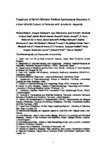Trajectory of Serum Bilirubin Predicts Spontaneous Recovery in a Real-World Cohort of Patients With Alcoholic Hepatitis
| dc.contributor.author | Parker, R | |
| dc.contributor.author | Cabezas, J | |
| dc.contributor.author | Altamirano, J | |
| dc.contributor.author | Arab, JP | |
| dc.contributor.author | Ventura-Cots, M | |
| dc.contributor.author | Sinha, A | |
| dc.contributor.author | Dhanda, Ashwin | |
| dc.contributor.author | Arrese, M | |
| dc.contributor.author | McCune, CA | |
| dc.contributor.author | Rowe, IA | |
| dc.contributor.author | Schnabl, B | |
| dc.contributor.author | Mathurin, P | |
| dc.contributor.author | Shawcross, D | |
| dc.contributor.author | Abraldes, JG | |
| dc.contributor.author | Lucey, MR | |
| dc.contributor.author | Garcia-Tsao, G | |
| dc.contributor.author | Verna, E | |
| dc.contributor.author | Brown, RS | |
| dc.contributor.author | Bosques-Padilla, F | |
| dc.contributor.author | Vargas, V | |
| dc.contributor.author | Louvet, A | |
| dc.contributor.author | Holt, AP | |
| dc.contributor.author | Bataller, R | |
| dc.date.accessioned | 2021-08-12T13:17:40Z | |
| dc.date.issued | 2021-01-28 | |
| dc.identifier.issn | 1542-3565 | |
| dc.identifier.issn | 1542-7714 | |
| dc.identifier.uri | http://hdl.handle.net/10026.1/17566 | |
| dc.description.abstract |
BACKGROUND AND AIMS: Alcoholic hepatitis (AH) is a severe condition with poor short-term prognosis. Specific treatment with corticosteroids slightly improves short-term survival but is associated with infection and is not used in many centers. A reliable method to identify patients who will recover spontaneously will minimise the numbers of patients who experience side effects of available treatments. METHODS: We analysed the trajectory of serum bilirubin concentration over the course of hospital admissions in patients with AH to predict spontaneous survival and the need for treatment. RESULTS: data from 426 patients were analysed. Based on bilirubin trajectory, patients were categorized into three groups: 'fast fallers' (bilirubin <0.8 x admission value at day 7), 'static' (bilirubin of >0.9 - <1.2 x admission value) and 'rapid risers' (bilirubin of ≥1.2 x admission bilirubin). Fast fallers had significantly better 90-day survival compared to other groups (log rank p < .001), and showed no benefit of corticosteroid therapy (OR for survival at 28 days of treatment, 0.94, 95% CI 0.06 - 8.41). These findings remained even amongst patients with severe disease based on initial DF, GAHS or MELD scores. CONCLUSIONS: We present an intuitive method of classifying patients with AH based on the trajectory of bilirubin over the first week of admission. It is complimentary to existing scores that identify candidates for corticosteroid treatment or assess response to treatment. This method identifies a group of patients with AH who recover spontaneously and can avoid corticosteroid therapy. | |
| dc.format.extent | e289-e297 | |
| dc.format.medium | Print-Electronic | |
| dc.language | en | |
| dc.language.iso | en | |
| dc.publisher | Elsevier BV | |
| dc.rights | Attribution-ShareAlike 4.0 International | |
| dc.rights | Attribution-ShareAlike 4.0 International | |
| dc.rights | Attribution-ShareAlike 4.0 International | |
| dc.rights | Attribution-ShareAlike 4.0 International | |
| dc.rights | Attribution-ShareAlike 4.0 International | |
| dc.rights.uri | http://creativecommons.org/licenses/by-sa/4.0/ | |
| dc.rights.uri | http://creativecommons.org/licenses/by-sa/4.0/ | |
| dc.rights.uri | http://creativecommons.org/licenses/by-sa/4.0/ | |
| dc.rights.uri | http://creativecommons.org/licenses/by-sa/4.0/ | |
| dc.rights.uri | http://creativecommons.org/licenses/by-sa/4.0/ | |
| dc.subject | Alcoholic Hepatitis | |
| dc.subject | Outcomes | |
| dc.subject | Corticosteroid | |
| dc.title | Trajectory of Serum Bilirubin Predicts Spontaneous Recovery in a Real-World Cohort of Patients With Alcoholic Hepatitis | |
| dc.type | journal-article | |
| dc.type | Journal Article | |
| dc.type | Research Support, N.I.H., Extramural | |
| dc.type | Research Support, Non-U.S. Gov't | |
| plymouth.author-url | https://www.webofscience.com/api/gateway?GWVersion=2&SrcApp=PARTNER_APP&SrcAuth=LinksAMR&KeyUT=WOS:000748508800024&DestLinkType=FullRecord&DestApp=ALL_WOS&UsrCustomerID=11bb513d99f797142bcfeffcc58ea008 | |
| plymouth.issue | 2 | |
| plymouth.volume | 20 | |
| plymouth.publication-status | Published | |
| plymouth.journal | Clinical Gastroenterology and Hepatology | |
| dc.identifier.doi | 10.1016/j.cgh.2021.01.042 | |
| plymouth.organisational-group | /Plymouth | |
| plymouth.organisational-group | /Plymouth/Faculty of Health | |
| plymouth.organisational-group | /Plymouth/Faculty of Health/Peninsula Medical School | |
| plymouth.organisational-group | /Plymouth/REF 2021 Researchers by UoA | |
| plymouth.organisational-group | /Plymouth/REF 2021 Researchers by UoA/UoA01 Clinical Medicine | |
| plymouth.organisational-group | /Plymouth/REF 2021 Researchers by UoA/UoA01 Clinical Medicine/UoA01 Clinical Medicine | |
| plymouth.organisational-group | /Plymouth/Research Groups | |
| plymouth.organisational-group | /Plymouth/Research Groups/Plymouth Institute of Health and Care Research (PIHR) | |
| plymouth.organisational-group | /Plymouth/Users by role | |
| plymouth.organisational-group | /Plymouth/Users by role/Academics | |
| dc.publisher.place | United States | |
| dcterms.dateAccepted | 2021-01-24 | |
| dc.rights.embargodate | 2022-1-28 | |
| dc.identifier.eissn | 1542-7714 | |
| dc.rights.embargoperiod | Not known | |
| rioxxterms.versionofrecord | 10.1016/j.cgh.2021.01.042 | |
| rioxxterms.licenseref.uri | http://creativecommons.org/licenses/by-sa/4.0/ | |
| rioxxterms.licenseref.startdate | 2021-01-28 | |
| rioxxterms.type | Journal Article/Review |



